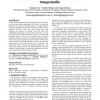Free Online Productivity Tools
i2Speak
i2Symbol
i2OCR
iTex2Img
iWeb2Print
iWeb2Shot
i2Type
iPdf2Split
iPdf2Merge
i2Bopomofo
i2Arabic
i2Style
i2Image
i2PDF
iLatex2Rtf
Sci2ools
SAC
2008
ACM
2008
ACM
An efficient feature ranking measure for text categorization
A major obstacle that decreases the performance of text classifiers is the extremely high dimensionality of text data. To reduce the dimension, a number of approaches based on rough-set theory have been proposed. However, these works often suffer from two problems: the first is that they cannot directly deal with continuous text features; the second is that they often incur considerable running time. To deal with the first issue, we make some extensions to discernibility matrix so that it can work with continuous features. To cut down running time, we employ centroids rather than examples to construct discernibility matrix, which reduce the time complexity from O(T2 W) to O(K2 W) where T denotes the size of training examples, K denotes the number of training classes and W denotes the size of vocabulary. The experimental results indicate that proposed method not only yields much higher accuracy than Information Gain when the number of selected features is smaller than 6000, but also in...
| Added | 28 Dec 2010 |
| Updated | 28 Dec 2010 |
| Type | Journal |
| Year | 2008 |
| Where | SAC |
| Authors | Songbo Tan, Yuefen Wang, Xueqi Cheng |
Comments (0)

